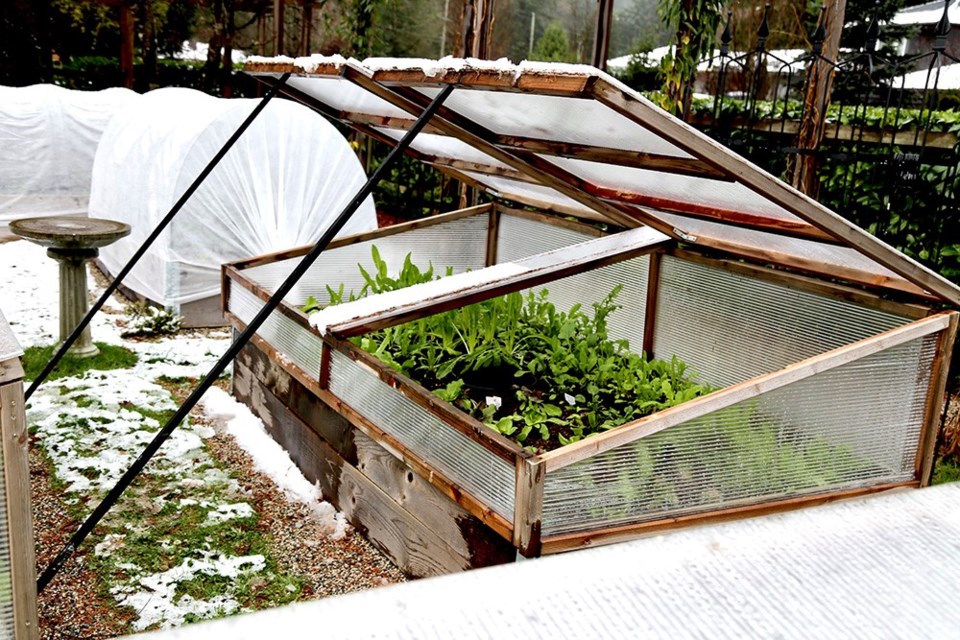Here on the North Shore, beautiful, colourful and nutritious winter greens are easy to grow in containers and in beds. All they need to protect them from bracing winds and crushing snow is a little love and a little cover.
When we apply "urban" permaculture thinking to non-rural settings, we can bend the seasons a bit to help us grow resilient crops year-round in our yards and on the smallest of patios, sundecks and rooftops. You see this in nature, on the margins of wild landscapes where under the part-sun natural cover and protection of shrubs, rocks and trees, a small meadow or riparian ecosystem has adapted beautifully, thriving even in a productive tableau of all-natural zone denial.
This year, after a tiring six months of back-to-back extreme weather events, it was all I could do to drag my weary boots out into the rain and cold to transplant the small starts grown from seed in our old greenhouse, into their winter homes.
The plant babies seemed less than happy at the time, looking somewhat neglected and bedraggled following many, many weeks in too-tiny pots and without the benefit of delicious in-ground soil biology within a greater ecosystem.
Just as soon as their little roots set foot in the healthy soil outside — covered loosely as it was with either hooped fleece, cold frames, or high glass patio roof — they got busy settling in for the duration. Instantly the plants made friends as plants do, with mycelium and microbes and organisms within their individual and collective rhizospheres, or root zones.
It’s a beautiful thing, the complex pluralistic environment that exists below the surface of healthy soil, in the so-called soil food web. Consider that just one tablespoon of healthy, living soil such as that found in rich forest floor humus contains more microbes than there are people on this planet. Awesome, right?
Within a few short weeks in their nutrient-dense forever homes, the greens had made up for lost time, growing up and out substantially, in equal measure. Nature truly is so clever and intuitive so it is no surprise that, when we biomimic her in big and small ways, she responds accordingly.
This is the "love" piece. By working throughout the year to observe permaculture principles, ethics, and traditions including no-dig organic gardening, in-bed vermicomposts, and polyculture planting within a larger edible ecosystem, we give our food plants the advantage they need to thrive in environments that were not determined through natural selection.
Canadian winters are notoriously heavy, and since most non-native food plants are somewhat breakable, they require some form of "inside outside" shelter from seasonal elements. This is the "cover" piece.
In cold-frame covered raised beds out front, we are growing a variety of mustards, chicories and radicchio, endive, arugula, winter purslane, spinach, rapini and other greens. Also in raised beds, under heavy fleece covered high hoops, various brassicas including kalettes, sprouting broccoli, broccolini, brokali, kale and collard greens have settled in.
Celeriac, cutting celery, par-cel, and perennial fennel are still chugging alongside here and there, as are some late-summer carrots, parsnips and turnips. The root vegetables grow sweeter with the cold, but also provide diversity above and below the surface.
Around back, perennial fennel, cutting celery, woody herbs, sorrel and white beets seem content in patio pots set under the eaves or the glass patio cover, protected from the wind and the snow.
I ran out of steam and dry clothes before I could get the adolescent multi-sown gold and striped beets into the ground, so I will interplant them in patio pots under cover around back. One never knows with beets, if they will thrive or arrest when transplanted, but since tender beet greens are always on the menu, I will locate them very near to the kitchen door, where I can pop out in my slippers at a moment’s notice.
As soon as the deep cold hits, my plant babies will slow down and slumber ever so quietly until mid-February or so when the length and quality of sunlight nudges them awake, and me to think about starting tomato, pepper and eggplant seeds indoors.
And so it goes.
Laura Marie Neubert is a West Vancouver-based urban permaculture designer. Follow her on Instagram @upfrontandbeautiful, learn more about permaculture by visiting her Upfront & Beautiful website or email your questions to her here.
For a taste of permaculture, click on the YouTube link below:
(Video - Courtesy of West Vancouver Memorial Library)



